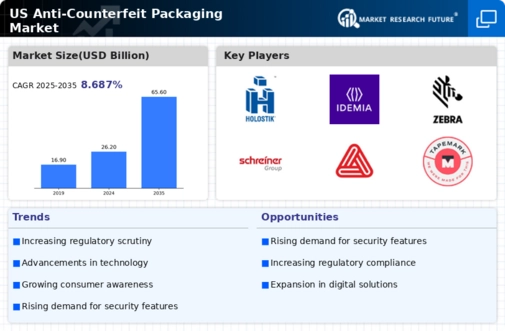Growth of E-commerce
The rapid growth of e-commerce in the US is significantly impacting the anti counterfeit-packaging market. As online shopping continues to expand, the risk of counterfeit products being sold through digital platforms increases. This trend has prompted e-commerce companies to prioritize secure packaging solutions to protect their brands and consumers. It is estimated that e-commerce sales in the US will reach $1 trillion by 2025, further amplifying the need for effective anti-counterfeiting measures. The anti counterfeit-packaging market is likely to benefit from this growth, as businesses seek to implement packaging that not only deters counterfeiting but also enhances the overall consumer experience. This shift towards secure packaging in e-commerce is expected to drive innovation and investment in the industry.
Rising Consumer Awareness
The increasing awareness among consumers regarding counterfeit products is a pivotal driver for the anti counterfeit-packaging market. As consumers become more informed about the risks associated with counterfeit goods, they are more likely to demand products that are securely packaged. This heightened awareness is reflected in a survey indicating that approximately 70% of consumers in the US express concern over counterfeit items. Consequently, brands are compelled to invest in advanced packaging solutions to ensure authenticity, thereby propelling growth in the anti counterfeit-packaging market. The industry is witnessing a shift where consumers actively seek out brands that prioritize security features in their packaging, which in turn influences purchasing decisions and brand loyalty.
Evolving Regulatory Landscape
The evolving regulatory landscape in the US is a significant driver for the anti counterfeit-packaging market. Government agencies are increasingly implementing stringent regulations aimed at combating counterfeit goods, particularly in sectors such as pharmaceuticals and consumer electronics. For instance, the Drug Quality and Security Act mandates enhanced security measures for drug packaging, which has led to a surge in demand for anti counterfeit solutions. This regulatory push is expected to create a market environment where compliance becomes a necessity for businesses, thereby driving growth in the anti counterfeit-packaging market. Companies that proactively adapt to these regulations are likely to gain a competitive edge, as they can assure consumers of product authenticity and safety.
Technological Advancements in Packaging
Technological advancements play a crucial role in shaping the anti counterfeit-packaging market. Innovations such as QR codes, holograms, and RFID tags are increasingly integrated into packaging solutions to enhance product security. The market is projected to grow at a CAGR of approximately 12% over the next five years, driven by these technological enhancements. Companies are leveraging these technologies to create packaging that not only protects against counterfeiting but also provides consumers with easy access to product information. This trend indicates a shift towards more interactive and secure packaging solutions, which are becoming essential in the anti counterfeit-packaging market. As technology continues to evolve, the industry is likely to see even more sophisticated solutions that address the challenges posed by counterfeit products.
Increased Investment in Brand Protection
Increased investment in brand protection strategies is a notable driver for the anti counterfeit-packaging market. Companies are recognizing the financial implications of counterfeiting, which can lead to substantial revenue losses and damage to brand reputation. As a result, businesses are allocating more resources towards anti-counterfeit measures, including advanced packaging solutions. The anti counterfeit-packaging market is projected to see a surge in demand as brands seek to safeguard their products. This trend is particularly evident in industries such as luxury goods and pharmaceuticals, where the stakes are high. By investing in secure packaging, companies aim to enhance consumer trust and loyalty, which is essential for long-term success in the competitive marketplace.





















Leave a Comment